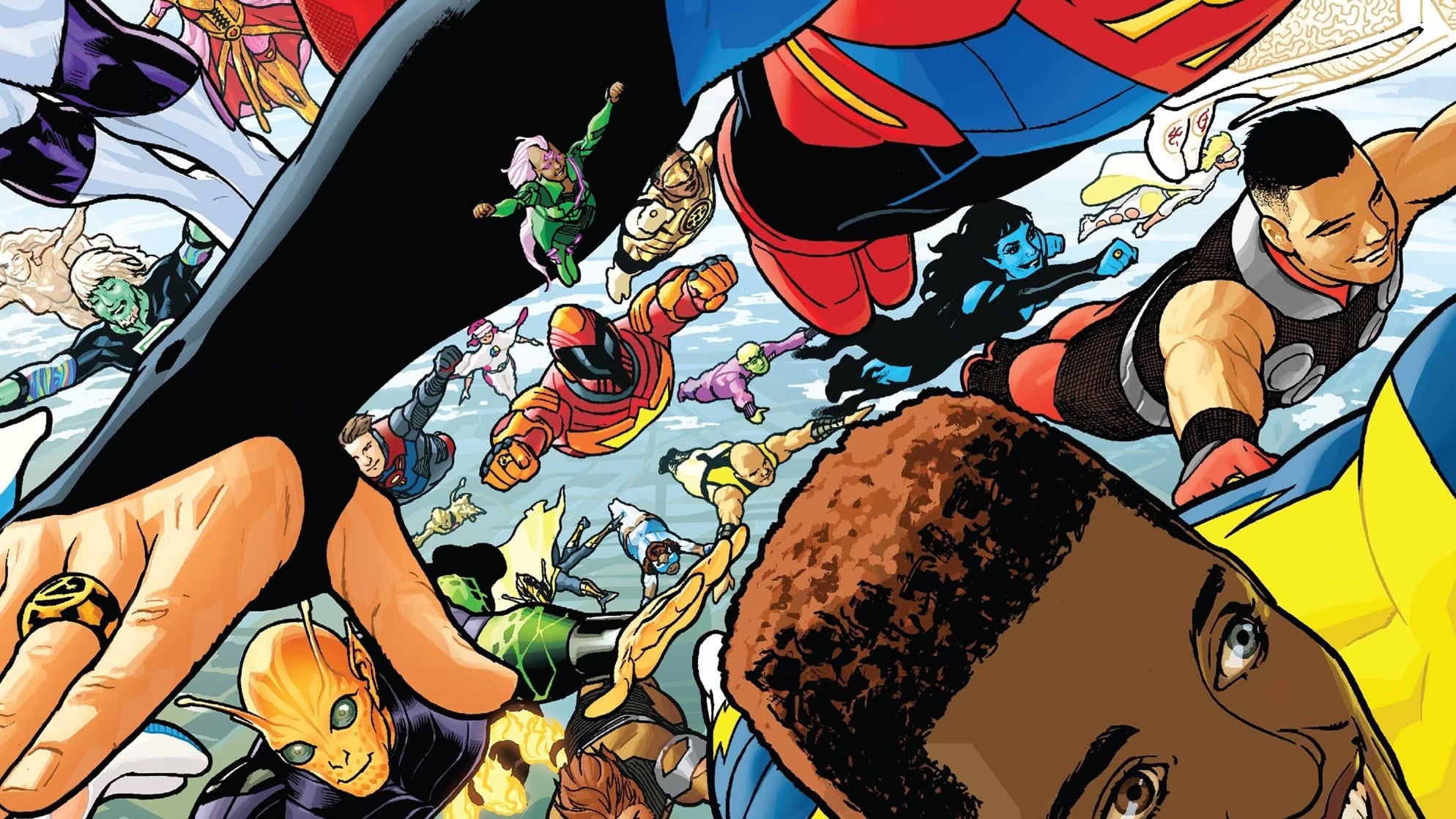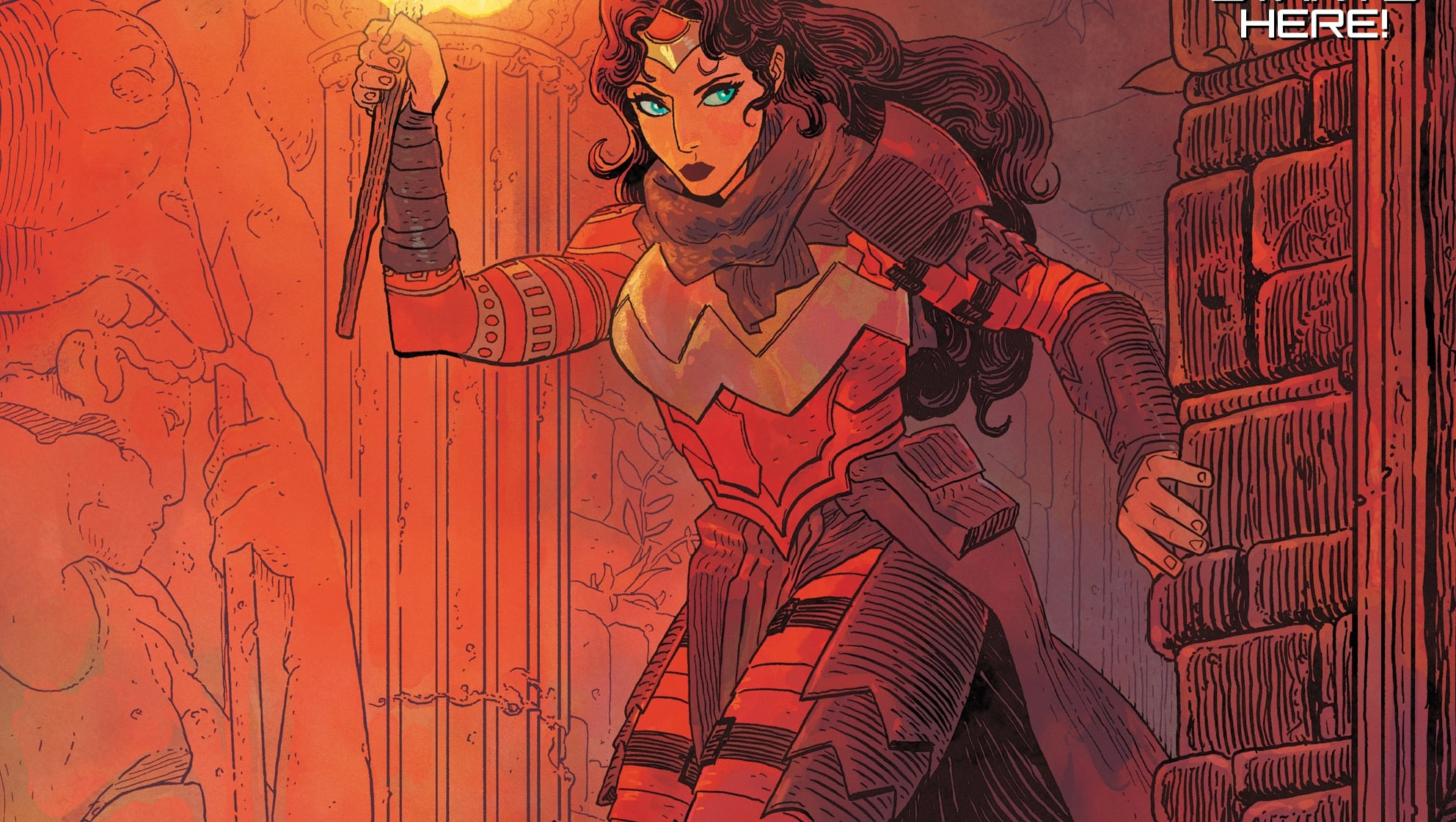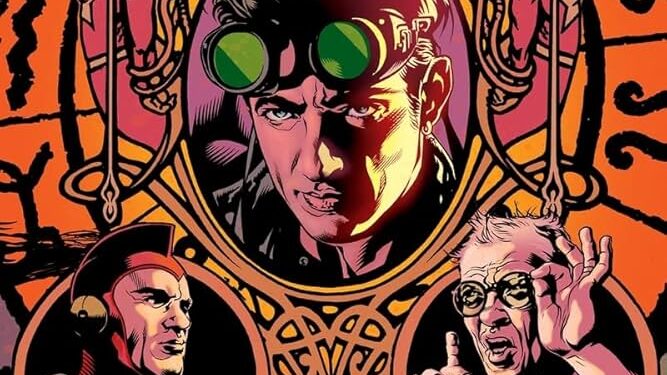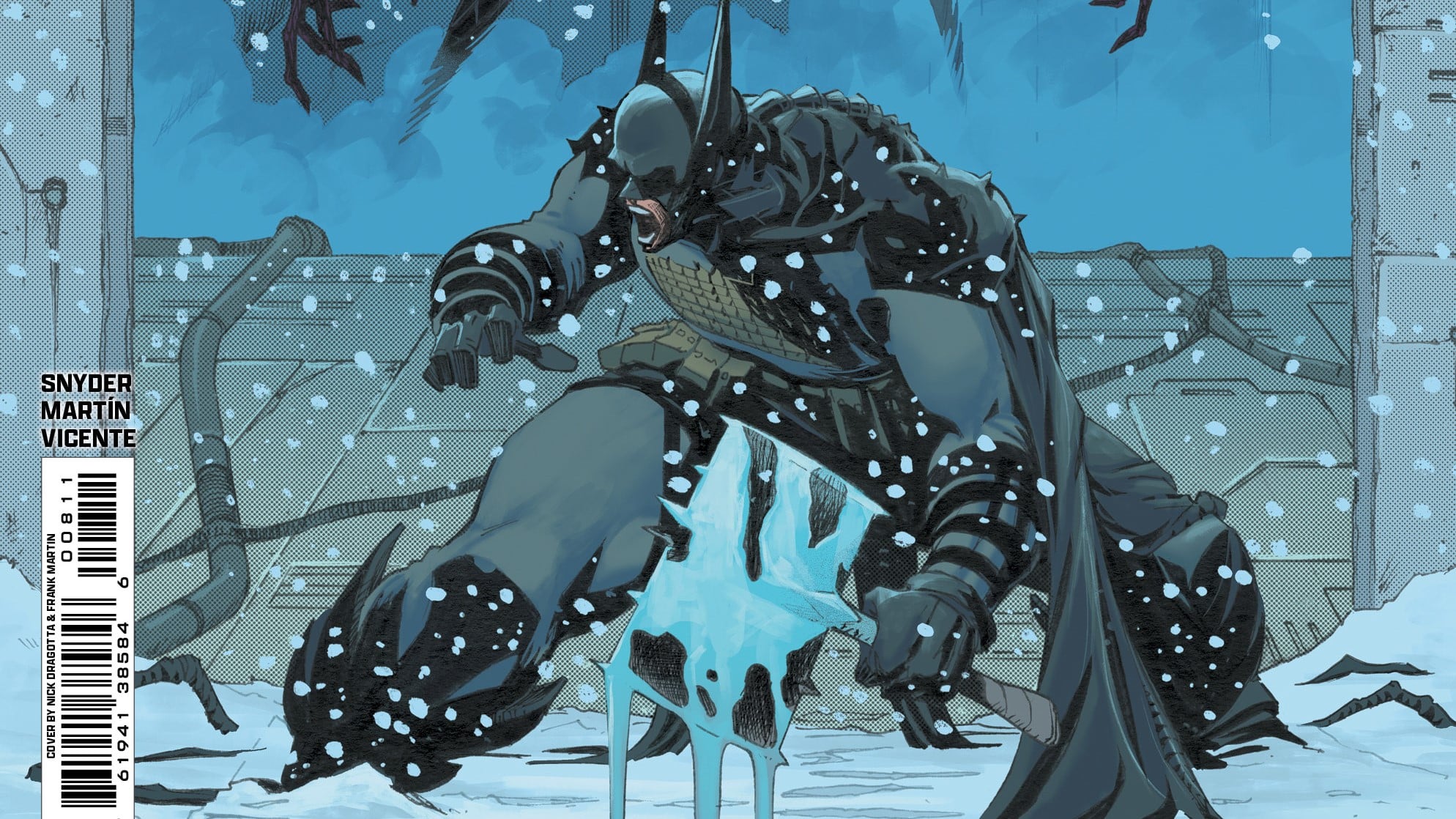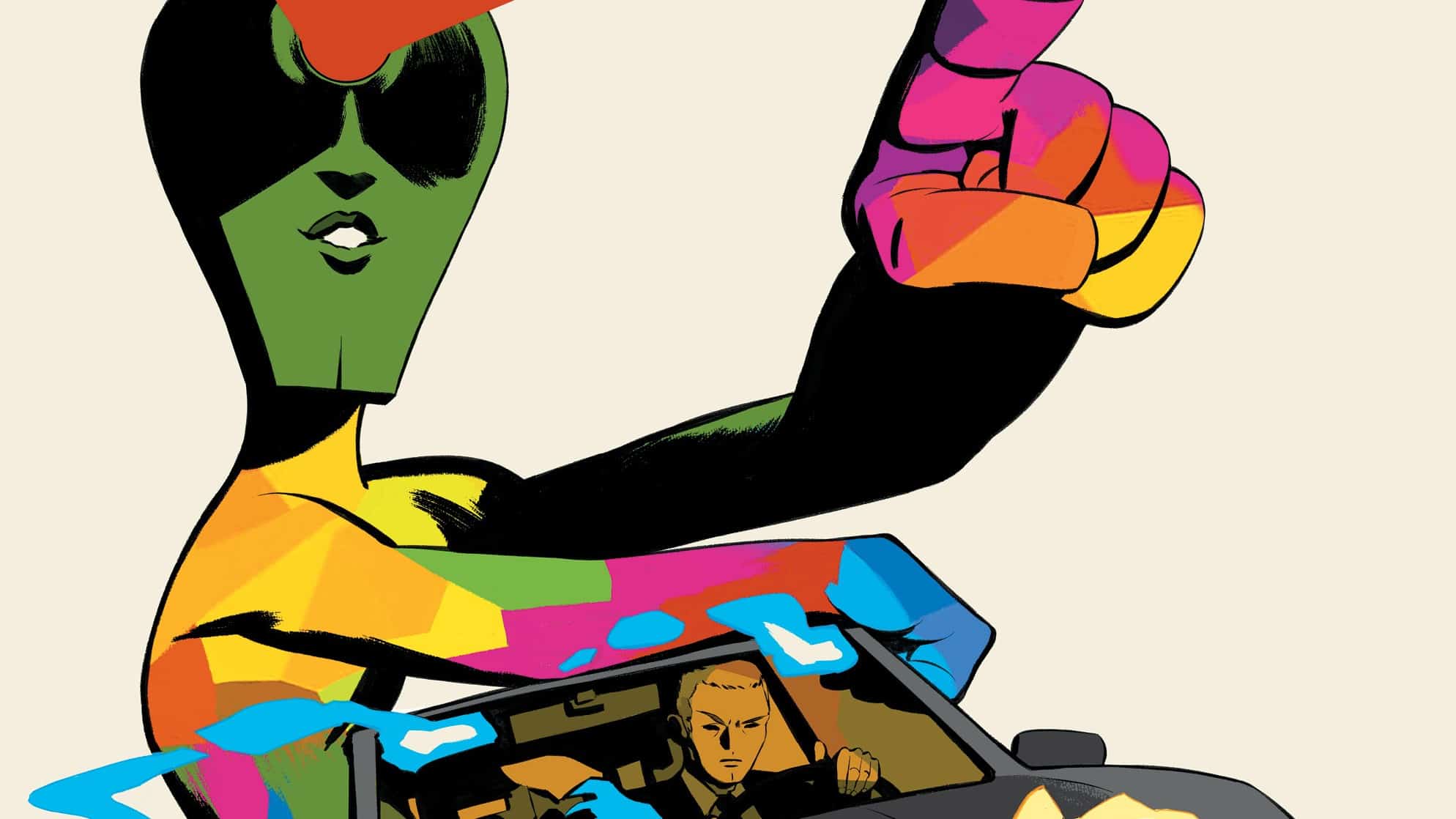For part one of Margot Waldman’s deep dive into the history of DC’s Legion of Super-Heroes and its fandom, click here.
In 1981, after a baffling run by Roy Thomas, the Legion would get a new writer in DC executive Paul Levitz. He would soon be joined by artist Keith Giffen. Both were avid members of Interlac, where Giffen corresponded at length with fans like Tom Bierbaum, who gave him ideas for new costumes. Together, they created a Legion whose plotting was legendarily tight, despite the by-now enormous cast of characters and galaxy-spanning storylines. Levitz supposedly used notecards and string to keep the cast of over 20 Legionnaires straight. With stories like “The Great Darkness,” which pitted the Legion against Darkseid, sales — and reviews — were never better. (This run is probably still the best starting place, by the way.)

What made Levitz and Giffen’s Legion work? It was something beyond their obvious and abundant love for the Legion and its history. Their run worked not just because of the richly drawn characters and the depiction of a future world Giffen’s art made seem so real that the machinery almost creaked. It worked because it maintained the dream, even though the world had changed, and not for the better.
Is it any wonder, then, that the Legion had so many queer fans in the ’80s? Indeed, some of those fans, like artist Phil Jimenez and his partner Neal Pozner, who tragically died of AIDS in 1994, turned pro. Queer fans — queer creators — needed a future more than anything. If the Legion’s hopefulness was almost naive, it was at least completely pure. True, the Legion had high standards — they saved the galaxy every month! — but their future was for everyone, as Jimenez recalled in DC Pride 2024:

Fandom identified Element Lad as queer by the ’70s (he wore pink, he didn’t date girls, he and Matter-Eater Lad had explored each other’s bodies in some fanfiction I haven’t been able to find). During the ’80s golden era, Levitz wrote Lightning Lass and Shrinking Violet as a couple. It was hard not to read Dream Girl as being actively and eagerly polyamorous in a series where characters openly speculated on what happened in the boudoir between Colossal Boy and his shapeshifting wife, Yera. If the X-Men are queer, then so are the Legion.
Riding high yet exhausted from drawing a poster of every single Legion character, Giffen left the series. Legion proved more than strong enough to weather a creative change: It stayed very good. Still a cult favorite, now it sold well. When Shooter’s Marvel toyed with buying DC in the mid-’80s, Legion was deemed one of the seven titles that had to stick around after the acquisition, along with Batman and Superman. It seemed nothing could dethrone the Legion.
But then something did.
1986’s Crisis on Infinite Earths touched practically everything, except for the titles like Legion that sold well (think New 52 Green Lantern). Even Superman rebooted himself in the John Byrne-penned Man of Steel, thereby removing Superboy, but the Legion’s precious continuity, its chain of parasocial relationships to characters established in readers’ teens, its carefully maintained headcanons and fan theories, seemed spared.
Really it had just been granted a stay of execution. Its days were numbered.
Weathering the resulting retcons (the Legion’s Superboy, we learned, was, unbeknownst to him, really an impostor: He sacrificed himself nobly for the team he loved), Levitz was by now clearly a bit tired out by a cumulative decade on the Legion. He finally concluded his tenure in 1989 — Keith Giffen, as the Byrne to his Claremont, was the natural successor, especially since Giffen had recently helped revive the moribund Justice League into a quirky, fascinatingly cynical, comedy title. Giffen was excited to take on the Legion, but he didn’t want to live in Levitz’s shadow: He believed the book needed a fresh start and a fresh approach. Watchmen had made superhero comics avant-garde: The Legion, set a thousand years in the future, should follow the future. It was about the passage of time, after all. It should be about upholding the dream over time.
So Giffen pitched what appeared to be a very different Legion to his chosen scripters, Tom and Mary Bierbaum. But, he stressed, it would always operate on the core premise of R.J. Brande’s dream of Superboy. “I wanted to take a dystopian future and transform it into the Legion’s positive future,” Giffen said years later for SKTCHD.
When readers picked up the new Legion of Super-Heroes #1 in 1989, they learned the year was now 2994: Five years had passed since Levitz’s run. Gone were the costumes, the flight rings, the code names. The Legion had disbanded. Its scattered ex-members tried to make ends meet in a suffering, chaotic galaxy. It was a far cry from the rocket ship clubhouses of yore. Rokk Krinn (no longer Cosmic Boy) was about to be a father; Jo Nah (formerly Ultra Boy) had turned into a roguish smuggler mourning the loss of his beloved Phantom Girl, who he had gone steady with since the ’60s. Giffen’s art had grown rougher, sketchier. The Bierbaums, meanwhile, routinely cut between times and places, reality and delusion. Some readers hated it immediately — some dropped it then and there.
But those who didn’t saw Chameleon Boy, going by his “real” name of Reep Daggle, tell Rokk that the Legion needed to come back, that it was time for them to prove what had been so good about them in the first place. In a sense, it was a test for the Legion in a changing comics market. Could the ideas of the Golden Age of Science Fiction still hold up? Could the Legion? Could the dream?
Giffen said yes — but only if the Legion kept moving forward. So he made the comic adult, but not in the sense of ultrasexy ultraviolence. Rather, it was about being an adult, about being a person raised by a maddening, wonderful, ridiculous thing called the Legion of Super-Heroes. It was about looking around at your comic book collection and seeing bills hidden under issues of Superboy and Adventure, about living with the dream and wondering if it could still work. It wasn’t subtle: When the Legion reformed, their new base was on an asteroid made of the space debris of the past. It was a comic that was about asking “where did the time go?” and “were we ever so young?” In his stories about growing up, about time passing, Giffen took just as much from Alan Moore as from Jim Shooter.

It was a comic, too, about owning mistakes. In the last five years, Shrinking Violet and Cosmic Boy’s planets had gone to war: Violet had done horrible things she could never apologize for. Lightning Lord, Lightning Lad and Lass’ unspeakably evil brother, had reformed. He regretted deeply all the pain he’d caused his siblings. He’d since found a man to love back home on Winath, and tried every day to make things right. Not everyone’s path had been uphill: Sun Boy, once the Legion’s resident lothario, realized he’d made too many compromises. He’d become a craven collaborator with Earth’s secret rulers. When he wasn’t starring in propaganda videos, he spent his time reminiscing about the past, wondering how he had gotten so far from where he had started. Couldn’t he get a second chance at the dream?
As it turned out, he could.

The so-called “SW6 Legion,” found in a horrific alien lab, were the Legion precisely as longtime fans wanted to remember them, as the golden children of the Shooter years. Ferro Lad wasn’t even dead yet. As brilliant an idea as it was to bring back these naive young Legionnaires to meet the wartorn Legion of the ’90s, it inevitably brought about the Legion’s self-replacement. It was meant to prove that one couldn’t go home again, but to fans put off by Giffen’s ambition, it showed the opposite. What was meant as a tragic reminder of the inevitability of progress accidentally became a reactionary symbol. The new old Legion simply stuck around and eventually received its own title, Legionnaires. At times, even the series’ art was opposed to the new regime. Overworked, Giffen had to turn to fill-in artists, who seemed uninterested in the series’ trademark nine-panel grid, drawing standard ’90s action. It seemed like the future was slipping away.
Some of the missteps of Giffen’s Legion were undeniably of his own making. “When you work with Keith,” Tom Bierbaum remembered J.M. DeMatteis warning him, “you spend a great deal of your time trying to keep him from going off a cliff. … Keith wants to do something and you know it’s insane, and you yank him back and you yank him back and you finally talk him from going over that cliff. And then Keith goes, ‘Yeah, but look how close you got to the cliff. And you would never have gotten there if I hadn’t pulled you.’”
The simple fact of the matter is that for all its ambition and brilliance, the book was off-putting, sometimes deliberately so. Giffen pushed too far sometimes, and to a modern reader, some of his decisions seem more rash than bold. Forcibly detransitioning Shvaughn Erin, Element Lad’s girlfriend (revealed to be a transgender woman on “Profem”), so fans who liked the two and fans who wanted (reasonably enough) Element Lad to be with a man could both be happy reads, at best, very strangely today.
But not all of the missteps were authorial or intentional: Some were corporate. The title was forced, just five issues in, to remove the barest mentions of Superman, then mentions of the rest of the DC Universe. How could there be a Legion, or a dream, without a Superman? The title’s happy isolation now felt like being cut adrift. Through it all, the book kept going. Mon-El, rechristened “Valor,” would awkwardly take Superboy’s place as R.J. Brande’s totemic inspiration for the youth of tomorrow. It was probably naive to think it would work: retcon after retcon made for what Mark Waid called “death by a thousand cuts.” With each cut went readers. Sales plateaued, then cratered.
The fans blamed Tom and Mary Bierbaum, but they really blamed Giffen. Some still do. I don’t think that’s fair, though: This was a comic book that, in a sense, could no longer exist. It reminds me of Chris Claremont’s struggles to keep the X-Men moving forward, his desperate, doomed fight to let Cyclops stay married to Madelyne Pryor, to let him grow up. When Shooter revived Jean Grey, Claremont nearly quit then and there. When he did leave in 1991, he was understandably quite bitter about having his ideas shut out of the title he’d given his all to.
Giffen had done just as much for the Legion, as an artist and writer. So when he was kicked off Legion, he blew up the Earth.

It was left to the Bierbaums to find what was left. Not much was. They had 14 months or so remaining on their contracts, and gamely attempted to keep the books going for the new tastes of the ’90s. With the talents of Chris Sprouse on Legionnaires, they launched a second ongoing, the first Legion had ever had, starring the young Legion, now said to be as original as the originals. Under Sprouse, of course the new Legionnaires looked beautiful, but the Bierbaums must’ve known they’d reached the end of the road.
True, they tried to make the new Legion fit the standards of a ’90s super-team. But their issues read oddly, as if they were written somehow unwillingly. The Bierbaums were not always perfect writers: Their Giffen-less work tends toward stiff, prim yarns where characters affirm fan theories about each other (yes, Dream Girl and Matter-Eater Lad have fucked). Faced with the challenge, impossible perhaps, of fixing a Legion that didn’t even have an Earth, their writing suffered. Now it was just plain forced. The younger Lightning Lad, going by “Live Wire,” wore a backward baseball cap and said the word “yo.” The new Legionnaires couldn’t hold a candle to the Siegel-Hamilton-Shooter years.
Desultorily, the Legion limped toward the reboot it had avoided in 1986. With 1994’s Zero Hour, its stay of execution was finally up. To save the universe, the older Legionnaires melded with their younger counterparts, and an entirely new continuity was born. To be sure, Waid’s rebooted Legion is good. Characters like Gates and XS did a great deal to make the team fresher, more diverse (certainly something the lily-white Legion always needed). But the stories eerily rhymed with old ones — the title could never escape its past. It was as though every member of the team was Valor — every member was trying to fill a gap of some kind, or allude to a past story, or fix a newly discovered problem. It could never escape what had happened in 1994 — or 1986.
If you can reboot a title once due to tangled continuity and flagging sales, you can do it again — or, in the Legion’s case, four times. In 2003, flagging sales led to the “Threeboot” (a new, third continuity) then, a few years later, to Geoff Johns’ “Retroboot,” which tried to return the team to the Levitz era. Levitz was even back as writer, but it was no good — it was impossible to tell what had and hadn’t been real. The 30th century was wearing thin, and fan interest understandably trickled away. The last Legion title, just as confusing as its predecessors, lasted only 12 issues. As far as I know, there are no imminent plans for a new volume. Why should there be?
Interlac is online now. February 2025’s issue will “require” only 32 copies to be printed.
Did reboots kill the Legion? Probably. Did changing tastes kill the Legion? Undoubtedly.
But I don’t think Giffen did. By 1994, Legion was an anachronism in an industry devoted to franchising, to backward-looking continuity, to remembering when. Change and growth, so central to the Legion, were no longer in vogue. In a way, it was a miracle a story about the future had lasted as long as it had, since, after all, superhero comics are based on the illusion of change, where no time really passes, where nothing ever changes.
For over 30 years, one thing hadn’t changed about the Legion: its dream. The dream had been for everyone. It had been for everyone who had felt isolated and lonely, anyone who could find companionship and friendship (even, like Tom and Mary Bierbaum, life partners) through fandom. It was for queer fans and straight fans, Black and white, male and female. That dream is perhaps best encapsulated by a very early and very, very silly Legion story, 1961’s “Supergirl’s Three Super Girl-Friends!” by Jerry Siegel and Jim Mooney. In the Silver Age, Supergirl was a tragically lonely figure. To keep her safe from his enemies, Superman kept her in an orphanage, where Kara wore a mousy brown wig to avoid suspicion. She was far lonelier than Clark Kent had been in Smallville.
Only one day, she wasn’t.

This, to me, is R.J. Brande’s dream — the dream version of what comics and fandom can be for people, the dream of community through the unreal. At its best, a fandom is a shared, collective delusion, a very great dream that brings people together. Los Angeles’ Golden Age science fiction fanzine was called the Voice of the Imagi-Nation. Didn’t Legion fans, who wore flight rings, whose devotion was so extreme as to form a kind of secret code, have their own nation? They certainly had their own language.
The 30th century, where the buildings are shaped like rockets, where the weather is controlled, where the Lads and Lasses live, became, entirely accidentally, precisely what Phil Jimenez called it: a “queer utopia,” a kind of raygun Danny the Street, an atomic age Krakoa. (I should note here, by the way, that Jonathan Hickman and Al Ewing both are massive fans of Giffen’s Legion — Hickman has called it “probably the most influential book for what forms my general ethos on what a comic book story should be.” Meanwhile, the “Miracle Machine” Superman uses to save the multiverse in Grant Morrison’s Final Crisis is from Shooter’s Legion.)
It’s not hard to see why X-Men fandom is still around, still thriving, while the Legion stumbles from cameo to cameo. The world of the hyphenated superheroes is a long ways off, and certainly it took a lot of work to understand. The Legion are the only franchise that can make the mutants’ world look somehow simple. Besides, every day, the Sentinels’ world feels closer, the 30th century farther away.
But there is something very beautiful in Legion’s dream of radical optimism, in its dream of a Krakoa that wouldn’t fall to the destructions that seem so endemic to the mutant species. In its darkest era, the dream still lived on — fundamentally, it had to, though Lads and Lasses, Boys and Girls died. They were always so triumphant in whatever they did, in their perfect, shining world. Legion’s time has passed — and I’m sad, of course, but not too sad. Its successor is wonderful, too. These two blurred visions of a better world are not so much fandoms as dreams. The Legion’s fall came, ultimately, when that dream became harder and harder to spot. How could one fight for the 30th century if no one knows if there still is a 30th century?
Sometimes it seems like the Legion was the Proty to the X-Men’s Lightning Lad. It seems as though the Legion gave its life so something of itself could continue. I think we can try, like Lightning Lad and Saturn Girl, “to be worthy” of what the Legion did for us. It wouldn’t take much, really. It would just mean embracing the idea of a could-be utopia gleaming in the distant future, an untouchable millennium away.
But we know it’s there. It’ll always be there. There’s still a 30th century — there’s still a Krakoan dream.
It’s just like Chameleon Boy said:


Margot Waldman
Margot Waldman is a Mega City Two-based scholar, researcher and writer. Her great loves are old comics, Shakespearean theater and radical social justice – in no particular order. One day, she hopes to visit the 30th century.

